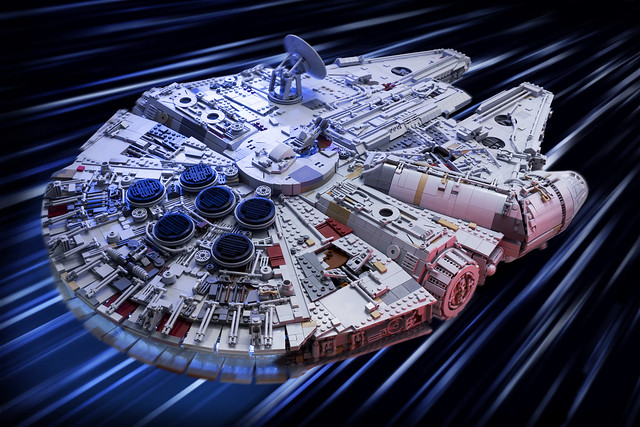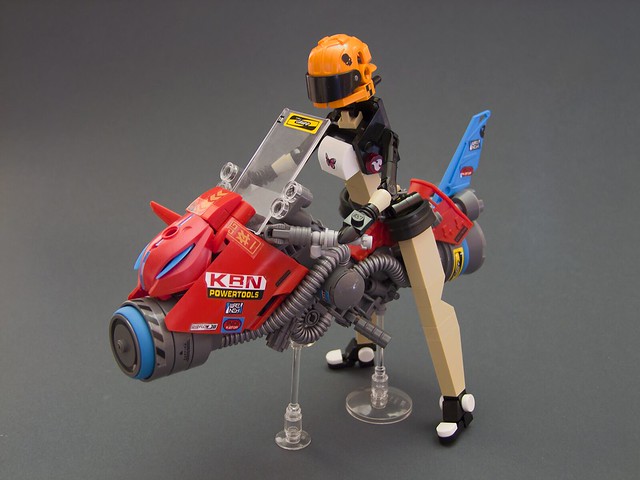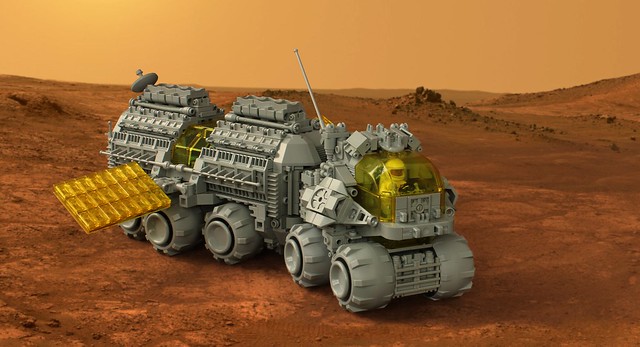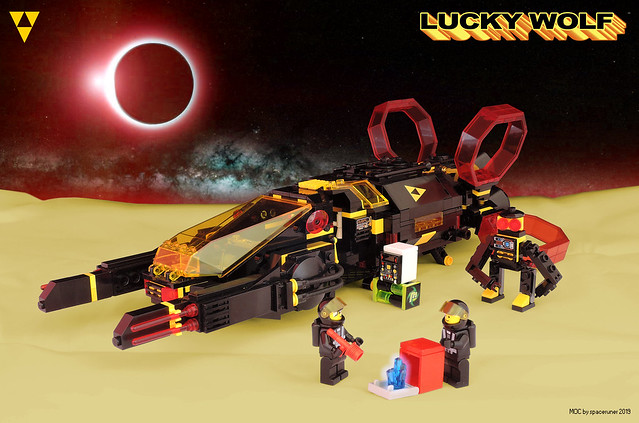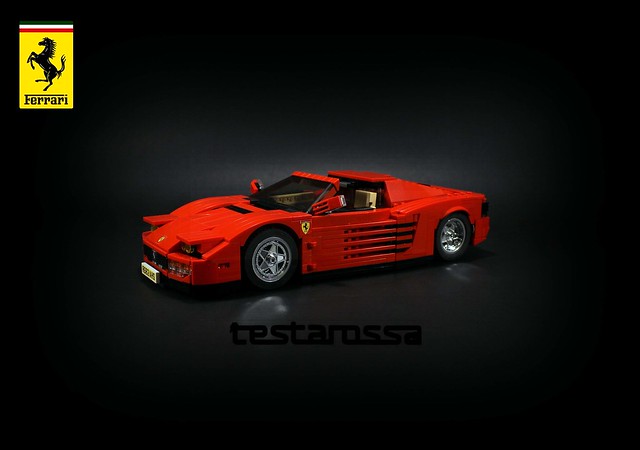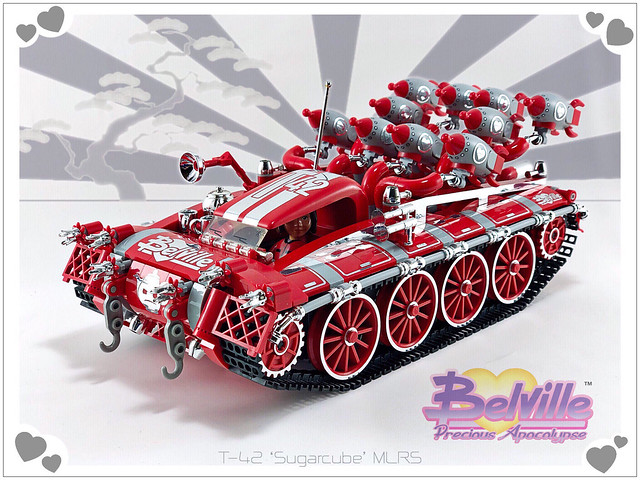Not too long ago, Alec Hole revealed his enormous Galaxy Explorer and now he’s back with a companion rover that’s just as exceptional. It stands out with a unique two-seater cockpit design for a pilot and his companion to go exploring the landscapes of distant planets. The rover’s cylindrical tanks at the back have some interesting-looking greebling that makes it look all authentic with serious space functions. To top it all, the highlight of the build is that this rover is built to fit into the cargo hold of Alec’s monumental Galaxy Explorer.
Tag Archives: Vehicles
Hannes Tscharner’s quest for a movie-accurate LEGO Millennium Falcon results in a 12,000-piece upgrade
Swiss builder Hannes “Marshal Banana” Tscharner has been in pursuit of a movie-accurate Millennium Falcon ever since he first shared his 7,500-piece custom LEGO Millennium Falcon back at the end of 2015. He’s recently overhauled his 2015 model thanks to some new parts that were released in the official Ultimate Collectors Series (UCS) 75192 Millennium Falcon in 2017.
His journey started when he was inspired by images and teaser trailers from The Force Awakens in November 2014. Back then, the largest official Millennium Falcon available was the 10179 UCS version with a part count of 5179 pieces. We learned from our interview with Hannes that his 2015 version stood at 7,500 pieces and wasn’t built in reference to any existing LEGO sets and was scaled to the cockpit referenced from the System-scale 75105 released for The Force Awakens earlier in the fall of 2015.
Click to see more stunning details of the 12000 piece Millennium Falcon
Super spiffy speeder bike and rider
The hovering speeder bike is a subject that has inspired many LEGO fan creators over the years, with many science fiction movies, comic books, and anime providing plenty of inspiration. Examples from popular culture often combine real-world mechanical bike features like windscreens, stickers, pedals and thrumming engines with fantastical fins, guns, and even bigger jet engines. Minifig scale versions are fairly common, but Djokson has opted to build a larger scale speeder bike complete with a sleek and racy rider.
Among the key details that get my heart racing are twisting flexible tubing running the length of the bike, connecting the front and rear engines to the fuel supply. Rubber tires turned inside out give the rider’s hips a smooth transition, and those boots made from just a few parts are a great visual focal point.
Safety, practicality, and dignified luxury mean nothing when raising hell
Many prefer the safety, practicality and reliability of a Toyota while driving to work. Others find that the versatile design and all-wheel drive of a Subaru speaks to their rugged sensibilities while exploring the great outdoors. Some, with greater means, may enjoy the sense of dignified luxury that a Lexus can provide. Chris Perron’s Gyrobike, on the other hand, is none of these.
Because when your name is Buzzsaw and you’re sporting a post-apocalyptic mohawk, you ain’t got time for dignified luxury, Jack! You’re all about rippin’ the road and raisin’ hell! Based on the wild concept designs of artist Calum Alexander Watt, this beast, like the Subaru, is also all-wheel drive. Meaning…it is all wheel and not much else. Can it pick up the kiddos from school? Sorry, rugrats, get your own damn ride! Can it get groceries at the local supermarket? Heck no! This Gyrobike is designed for crushing groceries! And heads, probably.
And a-roving, a-roving, a-roving I’ll go
See Mars the scenic way! Take a ride in Guido Brandis‘ fabulous All-Terrain Mobile Laboratory Rover. Its big fat wheels will stop you sinking into the dust, and its large solar panels should provide more than enough power for your journey plus any little experiments you might want to complete on the way. For a one-colour model, this manages to have remarkable visual impact, and that’s down to the density of the detail applied to every surface. This thing is greeble-tastic, with functional-looking elements applied everywhere — piping, antennae, comms dishes, and paneling. The presentation of the model is also excellent (nice work on the shadows in particular), making the vehicle look properly embedded in its environment. I’d love to hit Valles Marineris in this bad boy–those Martians, they see me rollin’ and they be hatin’.
Blacktron returns with the Lucky Wolf
When it comes to collecting vintage LEGO Space subthemes, Blacktron I has a strong following. LEGO’s first intergalactic villain faction has been reborn in the form of Spaceruner’s Lucky Wolf, clad in the classic Blacktron I colors of black, yellow, and trans red. One source of inspiration was set 6894 Invader, released in 1987. They have even gone so far as to create their own robot. By utilizing both vintage and modern parts, the end-result is a model that’s out of this world.
If you love Blacktron I, you might also enjoy this Blacktronesque laser mining vehicle we featured on April 16th.
Superfast redhead has the Italian look
It can be difficult to capture the smooth flowing lines of a beautiful sports car in LEGO without stepping up to a large scale. However Firas Abu-Jaber has managed to make this formidable challenge look easy with this excellent brick-built Ferrari Testarossa. The name means ‘Redhead’ in Italian, so naturally the colour scheme fits its inspiration, but the iconic shape of the famous supercar is also spot-on, with pop-up headlights, an impressively-raked windshield, and those long arcs over the wheels. However, the signature element to this car’s design was always the multiple slash intakes on the vehicle’s flanks, and here they’re recreated perfectly. Lovely building.
Not content with nailing the sumptuous curves of the car’s exterior, Firas has gone the extra mile and included a detailed interior complete with leather-look seats and a dashboard stuffed with instrumentation…
Shiny ride for a dark knight
Probably, the worst thing about being Batman is that you always have to keep a low profile. Whether you’re punching criminals or chasing a villain through the Gotham City, the less attention you’re drawing to yourself, the better. But how can Batman be okay with this lifestyle while driving a collection of jaw-dropping vehicles? ianying616 presents an ostentatious alternative: the ultimate edition of the famous Batpod. Completely covered in chrome, including many custom chromed elements, this vehicle was designed to draw the eye. The metallic color of the pieces goes perfectly with their shapes; all the LEGO Technic connectors and panels make the model look like a diecast.
Could Classic Space and Blacktron ever get along?
Looking at this Tracked Laser Mining Vehicle by Jon & Catherine Stead, the first thing that springs to mind is classic Blacktron. A few details seem out of place in this assumption and the description reveals no villainous intentions.
The yellow spacemen suggest this is in fact very much a peaceful vehicle. I particularly like the laser array, supported by strings going between pillars of translucent red 1×1 round plates. The ground is quite interesting as well, using an established technique and carrying us to a faraway moon or planet with its colours.
Roll a brand new car with the unknown stuntman
Let’s head back to 70s and 80s when no action movie was complete without a car chase and a pile-up. Check out Pixeljunkie‘s piece of Muscle-Car Movie Mayhem. This shot looks like a behind-the-scenes publicity image straight off the film set. There’s the director bellowing through his megaphone, the guy with the all-important clapperboard, and a nicely put-together boom camera capturing the action. The crashing cars themselves are simple enough models, but they’re well positioned. In conjunction with the dusty smoke effect, the dynamic angles suggest a high-speed crash, captured at the perfect moment.
This Mustang is in the shop for repairs
You may have noticed an abundance of Ford Mustangs featured on The Brothers Brick lately. The recent trend was ignited by a LEGO IDEAS contest, celebrating the Mustang in beautiful scenery. After wowing us by finding a Mustang in a barn, Andrea Lattanzio’s latest creation finds this Mustang in the shop. While the car itself is flawless, focus of the contest is on the scenery. And this garage is spot on.
The structure is rife with subtle yet brilliant techniques, from the checkered pattern on the wall – alluding to the shop owner’s dreams on race day – to the broken window adding that extra dose of realism. My favourite technique is the droid arms and skeleton legs suspending the overhead lights. Not to be overlooked is the apparent master class in brick built garage and warehouse tools. The pallet jack, air compressor, drill press, gas pump and table vice are all amazing details that help make this garage beautiful.
Care for a bit of apocalypse with your tea?
The mind of Andy Baumgart must be a very interesting place. Somewhere in that chaotic cranial coolness, there was a collision between the neurons responsible for housing the military schematics repositories, the hot rod files, and 90s girl LEGO themes. Thus, out popped the T-42 “Sugarcube” MLRS, which has got to be one of the most insane (and insanely awesome) military vehicles to ever grace our site.
Studded with nearly every chrome silver element LEGO has ever produced, and jazzed up even more with a generous dose of immaculately applied custom decals, this red rocket launcher houses a single Belville figure. As we’d expect with Andy, there’s no shortage of fantastic and unusual parts usages. The most obvious, of course, are rockets sprouting from the back which hail from the Series 17 Rocket Boy. The roof is a piece that isn’t seen often, but is actually being used for its intended purpose, having been a Fabuland vehicle top. Look closely, and along the side you’ll spot a well-disguised derrick arm, while Belville crowns and classic gates line the front. Of course, you wouldn’t want to miss tea time, so there’s a set just in reach of the driver.

